
Mars Global Surveyor
Mars Orbiter Camera
Mars Orbiter Camera Views the "Face on Mars"
Shortly after midnight Sunday morning (5 April 1998 12:39 AM PST), the
Mars Orbiter Camera (MOC) on the Mars Global Surveyor (MGS) spacecraft
successfully acquired a high resolution image of the "Face on Mars"
feature in the Cydonia region. The image was transmitted to Earth on
Sunday, and retrieved from the mission computer data base Monday
morning (6 April 1998). The image was processed at the Malin Space
Science Systems (MSSS) facility 9:15 AM and the raw image immediately
transferred to the Jet Propulsion Laboratory (JPL) for release to the
Internet. The images shown here were subsequently processed at
MSSS.
The picture was acquired 375 seconds after the spacecraft's 220th
close approach to Mars. At that time, the "Face", located at
approximately 40.8° N, 9.6° W, was 275 miles (444 km) from
the spacecraft. The "morning" sun was 25° above the horizon.
The picture has a resolution of 14.1 feet (4.3 meters) per pixel,
making it ten times higher resolution than the best previous image of
the feature, which was taken by the Viking Mission in the mid-1970's.
The full image covers an area 2.7 miles (4.4 km) wide and 25.7 miles
(41.5 km) long.
Weather Conditions at the Time of Imaging
Winter clouds cover much of the northern hemisphere of Mars above
40° N latitude at this time of the martian year. An image of the
Viking Lander 2 site (at 44° N) taken just over a day ago was
completely obscured by clouds. The image below shows a color
composite made from the red and blue wide angle cameras (the green
component is synthesized from the average of the red and blue frames).
The small box marks the location of the high resolution image. As can
be seen, fortuitously, the area imaged was relatively clear, although
the lack of surface definition in many nearby areas, and the low
contrast of the raw MOC high resolution image, suggests haze or fog
over much of the area.
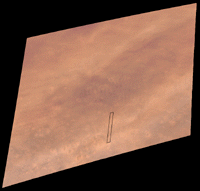
Color Wide Angle Image of Cydonia taken at same time as High
Resolution Image
654 KB JPEG
Location Images
The first two images below this paragraph are the best Viking pictures
of the area in Cydonia where the "Face" is located. For more
information about the "Face" and the Viking images, see http://www.msss.com/education/facepage/face.html.
Marked on the two images is the "footprint" of the high resolution
(narrow angle) camera. Also marked on the second of the images is a
dashed box outlining the area seen in enlarged views.
The third view is a one-quarter scale version of the full MOC image,
presented to show the "Face" in relation to the features in its
immediate vicinity. This image has been processed to enhance features
and project it into a mercator map perspective.
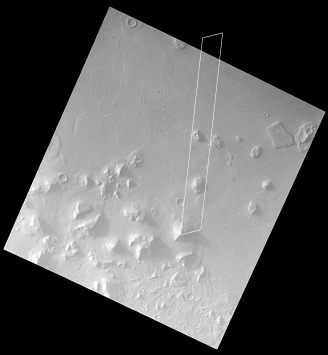
035a72.map
1.68 MB

070a13.map
1.64 MB

Full swath at 1/4th resolution
1.12 MB
Raw and Raw stretched
The images below this paragraph are portions of the raw image, and a
slightly contrast enhanced version of the raw image, that include the
"Face." The full raw image can be retrieved from the JPL WWW site by selecting either
the MGS icon (the upper right of the four icons shown on that page) or
by going to one of the many JPL Mars
mirror sites.
NOTE: The raw images shown immediately below (and on the JPL site)
are flipped left to right from the others shown on this page because
of the scan direction of the camera. All other images shown have had
their orientation corrected for this scan relationship.
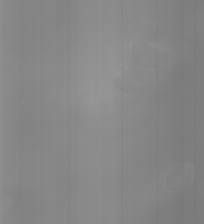
Section of raw image
584 KB

Contrast
enhanced raw image
584 KB
Processing
Image processing has been applied to the images in order to improve
the visibility of features. This processing included the following
steps:
- The image was processed to remove the sensitivity differences
between adjacent picture elements. This removes the vertical
streaking.
- The contrast and brightness of the image was adjusted, and
"filters" were applied to enhance detail at several scales.
- The image was then geometrically warped to meet the computed
position information for a mercator-type map. This corrected for the
left-right flip, and the non-vertical viewing angle (about 45°
from vertical), but also introduced some vertical "elongation" of the
image for the same reason Greenland looks larger than Africa on a
mercator map of the Earth.
- A section of the image, containing the "Face" and a couple of
nearly impact craters and hills, was "cut" out of the full image and
reproduced separately, as seen below.
For additional information on image processing, see:http://www.msss.com/education/facepage/vikingproc.html.
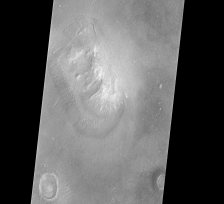
Calibrated, mercator map-projected (flipped left to right), contrast enhanced, filtered
543 KBytes
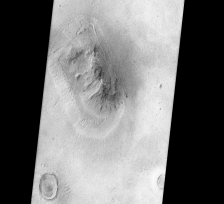
Brightness-inverted (dark to light)
version of calibrated, mercator map-projected (flipped left to right),
contrast enhanced, filtered
573 KB
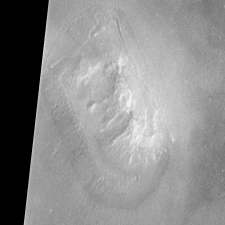
Just the "Face"
307 KB
Comparison of the Best Viking and Reduced Resolution MOC
Images
In the comparison below, the best Viking image has been enlarged to
3.3 times its original resolution, and the MOC image has been
decreased by a similar 3.3 times, creating images of roughly the same
size. In addition, the MOC images have been geometrically transformed
to a more overhead projection (different from the mercator map
projection of the preceding images) for ease of comparison with the
Viking image. The left image is a portion of Viking Orbiter 1 frame
070A13, the middle image is a portion of MOC frame 22003 shown
normally, and the right image is the same MOC frame but with the
contrast reversed (that is, light features were forced to be dark, and
dark features were forced to be light) to simulate the approximate
lighting conditions of the Viking image.

Comparison of
best Viking with two versions of MOC image
415 KB
Malin Space Science Systems and the California Institute of Technology
built the MOC using spare hardware from the Mars Observer mission. MSSS
operates the camera from its facilities in San Diego, CA. The Jet Propulsion
Laboratory's Mars Surveyor Operations Project operates the Mars Global Surveyor
spacecraft with its industrial partner, Lockheed Martin Astronautics, from
facilities in Pasadena, CA and Denver, CO.
 Go to MSSS home page
Go to MSSS home page
Contact: info@msss.com


![]()
![]()
![]()
![]()